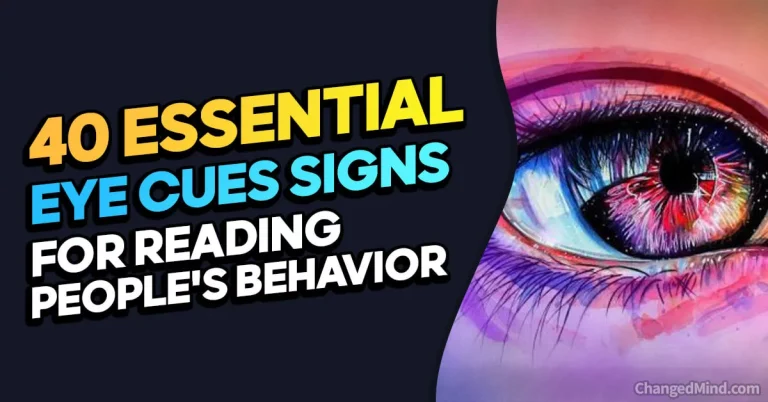Have you ever found yourself in a nerve-wracking situation where your palms get sweaty, your heart races, and you’re desperately trying to keep your cool?
Well, here’s a little secret: your body language might be giving you away. One telltale sign of nervousness that often goes unnoticed is the involuntary smile that creeps onto your face.
Yes, that’s right – smile when nervous is not just a quirky habit, but a fascinating aspect of nonverbal communication that can speak volumes about your inner state.
So, let’s dive into the intriguing world of body language and discover the hidden language of smiles when we’re feeling a bit jittery.
Smile When Nervous
Importance of Body Language in Communication
Before we delve into the peculiar phenomenon of smiling when nervous, it’s essential to understand the significance of body language in our everyday interactions. Did you know that a significant portion of our communication is nonverbal?
Research suggests that up to 55% of our message is conveyed through facial expressions, gestures, and posture, while only a mere 7% relies on spoken words. That means our body language plays a crucial role in how others perceive us and interpret our intentions.
By harnessing the power of nonverbal cues, we can become more effective communicators and better navigate social situations.
The Significance of Smiling When Nervous
Now, let’s focus on that peculiar phenomenon we mentioned earlier: smiling when nervous. It might seem counterintuitive – why would we smile when we’re feeling anxious or uncomfortable? However, this seemingly paradoxical behavior holds intriguing psychological and social implications.
When we smile, even when we’re nervous, we activate a cascade of physiological and psychological responses that can help alleviate stress and create positive connections with others. It’s like a little secret weapon hidden in our body language toolkit.
Overview of the Article’s Focus on Body Language and Nervous Smiles
In this comprehensive article, we’ll embark on a journey to unravel the science behind smiling when nervous and explore its various interpretations. We’ll dive into the psychological aspects of smiling, understand why we often resort to nervous smiles, and learn how to distinguish between genuine and forced smiles.
We’ll also explore the social implications of smiling when nervous, including its impact on dating experiences and professional interactions. Additionally, we’ll discuss techniques for managing nervousness through body language and share practical tips to help you project confidence in nerve-wracking situations.
Expert Says
Antoinette Bonafede, LMSW, DBT, REBT
Senior Associate Therapist, Gateway to Solutions

So, buckle up and get ready to decode the secrets of body language and the fascinating world of smiling when nervous. By the end of this article, you’ll have a deeper understanding of the nonverbal cues associated with nervousness, be equipped with practical tools to manage your own nervousness, and possess the knowledge to navigate social interactions with finesse. Let’s begin our journey into the captivating realm of nonverbal communication!
20 Reasons Why People Smile When Nervous

- To ease tension: Smiling when nervous can help release tension and create a more relaxed atmosphere, both for oneself and others involved.
- To appear friendly: Smiling can signal friendliness and approachability, making it easier for others to engage in conversations or interactions.
- To project confidence: A smile can give the impression of confidence, even when one may be feeling anxious inside. It can help create a positive image and boost self-assurance.
- To hide nervousness: Smiling can be a way to mask nervousness and avoid showing vulnerability in certain situations.
- To break the ice: Smiling can serve as a social cue to initiate or facilitate conversations, especially in unfamiliar or uncomfortable settings.
- To attract attention: Smiling can draw attention and make one more noticeable, which can be helpful when seeking assistance or standing out in a crowd.
- To diffuse awkwardness: A smile can help diffuse awkward or uncomfortable situations, making interactions smoother and more enjoyable for everyone involved.
- To cope with anxiety: Smiling when nervous can be a coping mechanism to manage anxiety and create a sense of control in challenging or stressful situations.
- To regulate emotions: Smiling can help regulate emotions by triggering the release of endorphins, which promote feelings of happiness and well-being.
- To convey positivity: Smiling conveys a positive vibe and can uplift the mood of both the smiler and those around them, fostering a more pleasant environment.
- To build rapport: Smiling can build rapport and establish a connection with others, enhancing communication and fostering a sense of trust.
- To express interest: Smiling can be a non-verbal way to show genuine interest in a person or topic, signaling engagement and encouraging further interaction.
- To reduce social discomfort: Smiling can alleviate social discomfort and help individuals navigate social situations more smoothly, providing a sense of ease.
- To enhance likability: Smiling can make a person more likable, as it creates a positive and welcoming impression on others.
- To overcome shyness: Smiling can help individuals overcome shyness or social anxiety, enabling them to interact more confidently with others.
- To appear more approachable: Smiling makes one appear more approachable and open to communication, inviting others to initiate interactions.
- To create a positive first impression: A genuine smile can leave a lasting positive impression on others, making it easier to build connections and relationships.
- To reduce perceived threat: Smiling can indicate non-threatening intentions, helping to reduce tension and perceived threat in potentially confrontational situations.
- To promote harmony: Smiling contributes to a harmonious social environment by fostering a positive and friendly atmosphere among individuals.
- To enjoy the moment: Smiling when nervous can simply be a way to embrace the present moment, finding joy and positivity even amidst nervousness or uncertainty.
The Science Behind Smiling
Psychological Benefits of Smiling
When you smile, even when you’re feeling nervous, something remarkable happens within your brain and body. Let’s take a closer look at the psychological benefits of this seemingly simple act:
- Release of Endorphins and Stress Reduction: Smiling triggers the release of endorphins, which are natural chemicals that contribute to feelings of happiness and well-being. These endorphins act as natural pain relievers and help reduce stress levels. So, even if you’re feeling anxious, the act of smiling can help alleviate some of that tension and promote a sense of calmness.
- Positive Impact on Mood and Well-being: Have you ever noticed how a genuine smile can instantly lift your spirits? Smiling releases neurotransmitters like dopamine and serotonin, often referred to as “feel-good” chemicals. These neurotransmitters not only boost your mood but also contribute to a greater sense of overall well-being. So, by smiling when nervous, you can trick your brain into feeling happier and more at ease.
Social Implications of Smiling
Beyond the psychological benefits, smiling when nervous also carries significant social implications. Here’s why:
- Enhancing Likeability and Approachability: A warm smile has the power to make you more likable and approachable, even in nerve-wracking situations. When you smile, you create an inviting and friendly atmosphere that puts others at ease. People are naturally drawn to individuals who appear open and welcoming, so your nervous smile can actually make you more approachable to others, whether in social or professional settings.
- Building Rapport and Trust: Smiling is a universal signal of goodwill and positivity. It helps to build rapport and foster trust between individuals. When you smile, you project a sense of authenticity and genuineness that can help establish stronger connections with others. This is particularly important when navigating relationships, both personal and professional. So, by smiling when nervous, you not only ease your own anxiety but also create a foundation for trust and rapport with those around you.
In summary, the act of smiling when nervous has both psychological and social benefits. It releases endorphins, reduces stress, and boosts your mood and well-being. Additionally, it enhances your likeability, approachability, and ability to build rapport and trust with others.
Expert Says
Sara Sloan, LMFT-Associate, MA Counseling
Marriage and Family Therapist, Austin Concierge Therapy

So, the next time you find yourself in a nerve-wracking situation, remember the power of your smile. Embrace it as a tool to not only alleviate your own nervousness but also create positive connections with those around you.
Smiling as a Nervous Response
Understanding the Link Between Nerves and Smiling
Have you ever wondered why smiling seems to be your go-to response when you’re feeling nervous? It may seem counterintuitive, but there’s a fascinating connection between nerves and smiling. When we experience anxiety or nervousness, our bodies react in various ways, and one of those responses is the automatic activation of facial muscles that produce a smile. It’s almost as if our body is trying to trick our mind into believing that everything is okay.
The Adaptive Function of Smiling When Nervous

Believe it or not, smiling when nervous serves an adaptive function. It can be traced back to our evolutionary roots and the way our ancestors navigated social interactions. Back in the day, when faced with potential threats or unfamiliar situations, our predecessors developed the instinct to smile. This response served as a non-threatening signal to others, indicating that they posed no harm and were open to social engagement.
Think of it this way: Imagine encountering a wild animal in the forest. If you were to show your teeth in a snarl, you would likely trigger a fight-or-flight response. On the other hand, if you were to smile, you would send a more calming and non-threatening signal, potentially defusing the tension. Our nervous smiles function similarly, signaling to others that we are not a threat and creating a more relaxed atmosphere.
Common Misconceptions About Nervous Smiles
Despite the adaptive nature of smiling when nervous, there are common misconceptions surrounding this intriguing phenomenon. Let’s debunk a few of them:
- Misconception 1: Nervous Smiles are Always Fake: It’s easy to assume that a smile displayed during nervousness must be insincere or forced. While it’s true that some nervous smiles can be inauthentic, not all of them are. Nervous smiles can be genuine expressions of our attempt to ease tension and connect with others.
- Misconception 2: Nervous Smiles Indicate Happiness: Smiling when nervous doesn’t necessarily mean you’re happy or enjoying the situation. It’s a subtle way our bodies cope with anxiety, but it doesn’t always reflect our true emotional state. It’s important to consider other nonverbal cues and context when interpreting someone’s emotional experience.
- Misconception 3: Nervous Smiles Should be Avoided: Some people may feel self-conscious about their nervous smiles and try to suppress them altogether. However, it’s important to embrace our nervous smiles and understand that they serve a purpose. Rather than trying to hide or suppress them, we can learn to manage and channel our nervous energy in more positive ways.
Understanding the link between nerves and smiling, recognizing the adaptive function of smiling when nervous, and dispelling common misconceptions can help us navigate social situations with more confidence and self-awareness. So, the next time you find yourself smiling when nervous, remember that it’s a natural response designed to facilitate social interaction. Embrace your nervous smile as a unique part of your body language repertoire and let it work its magic in diffusing tension and creating connections.
Interpreting Different Types of Nervous Smiles
Subtle and Genuine Nervous Smiles
When it comes to nervous smiles, not all are created equal. Some smiles may be more subtle and genuine, while others might appear forced or fake. Let’s explore the characteristics of subtle and genuine nervous smiles:
- Facial Expressions and Muscle Movements: Genuine nervous smiles often involve the activation of multiple facial muscles. You may notice a slight upward curvature of the lips, accompanied by the raising of the cheeks. The eyes may also show signs of involvement, with a softening or slight squinting effect known as “Duchenne’s smile.” These subtle but significant facial expressions convey authenticity and suggest that the smile is a natural response to nervousness.
- Eye Contact and Body Posture: Subtle and genuine nervous smiles are typically accompanied by appropriate eye contact and open body posture. When someone is genuinely smiling, they are more likely to maintain eye contact, indicating engagement and a desire to connect. Additionally, their body posture tends to be relaxed and open, displaying a sense of comfort and confidence despite the underlying nervousness.
Forced or Fake Nervous Smiles
While genuine nervous smiles convey authenticity, forced or fake smiles can give away signs of discomfort and insincerity. Here’s how to recognize them:
- Recognizing Signs of Discomfort and Insincerity: Forced or fake nervous smiles often lack the characteristic muscle movements associated with genuine smiles. The lips may be pressed tightly together or stretched in an unnatural manner. The absence of engagement from the eyes can also be a telltale sign. You may notice a lack of crinkling around the eyes and a fixed, stiff gaze. These subtle cues can indicate that the smile is not genuine and is being used as a defense mechanism to mask nervousness.
- Differentiating Between Genuine and Forced Smiles: Differentiating between genuine and forced nervous smiles can be challenging, but paying attention to the overall context and congruence of nonverbal cues is key. Consider the individual’s body language as a whole. Is their posture relaxed, or do they appear tense? Are their eyes showing signs of engagement, or do they seem distant? Trust your instincts and look for consistency among various nonverbal signals to determine whether the smile is genuine or forced.
Understanding the nuances of different types of nervous smiles can help you interpret the nonverbal cues more accurately and navigate social interactions with greater insight. Remember, genuine nervous smiles involve subtle facial expressions, engagement through eye contact, and open body posture. On the other hand, forced or fake smiles lack authenticity, with signs of discomfort and insincerity. By being attuned to these nonverbal cues, you can better understand others and respond accordingly, fostering more meaningful connections in both personal and professional settings.
Utilizing Nervous Smiles in Various Situations
Dating and Social Interactions
Breaking the Ice and Easing Tension
When it comes to dating or social interactions, nervous smiles can be powerful tools to break the ice and ease tension. Here’s how you can leverage your nervous smile to your advantage:
- Be Approachable: Your smile can make you more approachable, inviting others to initiate conversations with you. By smiling when nervous, you send a signal that you’re open to interaction and create a friendly atmosphere.
- Show Genuine Interest: Use your smile as a way to show genuine interest in the person you’re conversing with. A warm and authentic smile can make others feel more comfortable and encourage them to open up to you.
- Diffuse Nervous Energy: When you smile, even when nervous, it helps to release some of that pent-up nervous energy. Your smile acts as a natural stress reliever, allowing you to relax and enjoy the moment.
Attracting Potential Partners Through Genuine Smiles
Believe it or not, a genuine smile when nervous can be highly attractive to potential partners. Here’s why:
- Authenticity is Key: In the dating world, authenticity is highly valued. A genuine smile communicates that you’re comfortable being yourself, which can be incredibly appealing to others.
- Positive Vibes: Smiling sends positive signals to those around you. It exudes optimism, happiness, and a welcoming demeanor. Potential partners are naturally drawn to individuals who radiate positivity.
- Confidence Booster: Smiling when nervous can actually boost your confidence. As you project a confident and positive image, you become more attractive to others. Remember, confidence is attractive, and your smile can help you exude that confidence.
Professional Settings
Expert Says
Professional Problem Solver and Relationship Expert | Author, “Toxic Person Proof: Clear the Confusion and Learn to Trust Yourself“

Interview Strategies and Projecting Confidence
Job interviews can be nerve-wracking, but your nervous smile can come to your rescue. Consider the following strategies:
- Warm First Impressions: A genuine smile during an interview can help you make a warm and memorable first impression. It showcases your enthusiasm and approachability, setting a positive tone for the entire conversation.
- Easing Tension: Smiling when nervous can help alleviate some of the tension you may feel during the interview. It’s a natural way to release stress and create a more relaxed atmosphere for both you and the interviewer.
- Displaying Confidence: Your smile can project confidence, even if you’re feeling nervous inside. Confidence is a key trait employers look for, and a genuine smile can help you demonstrate that you’re comfortable and capable in professional settings.
Collaborative Work Environments and Team Dynamics
Nervous smiles can also play a role in collaborative work environments. Here’s how you can utilize your smile to foster positive team dynamics:
- Building Rapport: Smiling when nervous can help you build rapport with your colleagues. It shows that you’re approachable, friendly, and open to collaboration. Your smile can contribute to a harmonious and productive work atmosphere.
- Creating a Positive Environment: A warm smile can uplift the mood of your team members and create a positive work environment. It sets a tone of friendliness and cooperation, making everyone feel more comfortable and motivated.
- Fostering Trust: Smiling when nervous can contribute to the development of trust within your team. By projecting authenticity and openness, you establish a foundation of trust, enabling effective collaboration and communication.
In both dating and professional settings, your nervous smile can work wonders. It helps break the ice, ease tension, and create positive connections. So, embrace your nervous smile as a valuable asset, and let it enhance your interactions and relationships in various aspects of your life.
Overcoming Nervousness Through Body Language
Techniques for Managing Nervousness
When nervousness strikes, it’s essential to have techniques in your arsenal to help you overcome it. Here are some effective methods to manage your nervousness:
- Breathing Exercises and Relaxation Techniques: Deep breathing exercises can help calm your nervous system and reduce anxiety. Practice inhaling slowly through your nose, filling your lungs, and exhaling deeply through your mouth. Combine this with progressive muscle relaxation techniques, where you tense and release different muscle groups to promote relaxation throughout your body.
- Positive Self-Talk and Visualization: Combat negative thoughts and self-doubt by practicing positive self-talk. Remind yourself of your capabilities and focus on your strengths. Additionally, visualize yourself succeeding and feeling confident in the situation that makes you nervous. This mental rehearsal can help alleviate anxiety and boost your self-assurance.
Implementing Confident Body Language
Did you know that your body language can influence your state of mind and help you project confidence, even when you’re feeling nervous? Here are some tips for implementing confident body language:
- Posture, Gestures, and Eye Contact: Stand tall with an upright posture, as slouching can convey a lack of confidence. Keep your shoulders relaxed and your head held high. Use purposeful gestures that accompany your speech and engage your audience. Maintain good eye contact, as it shows attentiveness and confidence. Remember, confidence is contagious, and your body language plays a significant role in conveying it.
- Using Smiles Strategically to Alleviate Anxiety: Smiling when nervous can be a powerful tool to alleviate anxiety and boost your confidence. By strategically incorporating genuine smiles into your interactions, you create a positive and friendly atmosphere, both for yourself and those around you. Smiling can help release tension, ease nervousness, and even make others perceive you as more approachable and likable.
For example, in a job interview, using a confident smile when appropriate can enhance your overall presence and create a positive impression. Similarly, during social interactions, a genuine smile can help you break the ice and put both you and others at ease.
Remember that body language is a two-way street. While your body language can influence how you feel, it’s also influenced by your internal state. By implementing confident body language, including smiles when nervous, you can create a positive feedback loop, where your body language boosts your confidence, which in turn reinforces your positive body language.
So, the next time you find yourself facing nervousness, take a deep breath, practice relaxation techniques, and implement confident body language. Let your posture, gestures, eye contact, and strategic smiles work in tandem to alleviate anxiety and project the confident version of yourself. With practice, you’ll find that your body language can have a transformative effect on your state of mind and how others perceive you, leading to more successful and fulfilling interactions.
Conclusion
In this article, we’ve explored the intriguing world of smiling when nervous and its impact on our interactions. Let’s recap the key points we’ve discussed:
- The Significance of Smiling When Nervous: Smiling when nervous is a natural response that can serve various purposes, including easing tension, projecting confidence, and fostering positive connections.
- The Science Behind Smiling: Smiling releases endorphins, reduces stress, and has a positive impact on our mood and well-being. It enhances likeability, builds rapport, and fosters trust in social interactions.
- Interpreting Different Types of Nervous Smiles: Subtle and genuine nervous smiles involve characteristic facial expressions, eye contact, and open body posture. Forced or fake smiles lack authenticity and exhibit signs of discomfort and insincerity.
- Utilizing Nervous Smiles in Various Situations: Nervous smiles can be powerful tools in dating and social interactions. They break the ice, attract potential partners, and create positive impressions. In professional settings, they can enhance interviews, foster collaborative work environments, and project confidence.
- Overcoming Nervousness Through Body Language: Techniques such as breathing exercises, positive self-talk, and visualization help manage nervousness. Implementing confident body language, including posture, gestures, eye contact, and strategic smiles, can boost confidence and alleviate anxiety.
Now, it’s time to embrace nervous smiles as a powerful tool for personal growth and successful interactions. Don’t be afraid to let your smile shine, even when nerves come into play. Remember that your smile is an authentic expression of who you are, and it can have a positive impact on both yourself and those around you.
Body language, including smiling when nervous, is a crucial aspect of communication. By understanding and utilizing it effectively, you can navigate social situations with more confidence and create meaningful connections.
So, the next time nerves kick in, take a deep breath, flash a genuine smile, and let your body language work in harmony with your thoughts and emotions. Embrace the power of your smile and unlock the doors to more rewarding and fulfilling interactions.
In the end, remember that body language is just one piece of the puzzle. Personal growth is a journey, and it encompasses various aspects of self-improvement. Stay curious, continue learning, and explore the vast realm of psychology, relationships, and communication. As you develop your understanding of body language and its nuances, you’ll enhance your ability to connect with others and cultivate more meaningful relationships.
Here’s to the transformative power of body language and the genuine smiles that light up our lives!
FAQ
Why do people smile when they’re nervous?
Smiling when nervous is a natural response linked to our body’s stress and emotional regulation systems. It can help release tension and signal a friendly, non-threatening demeanor in social interactions.
Can smiling when nervous help alleviate anxiety?
Yes, smiling can have a positive impact on anxiety. It triggers the release of endorphins, which promote feelings of well-being and reduce stress. Smiling can also create a more relaxed atmosphere, easing nervousness.
How can I differentiate between a genuine and forced smile when nervous?
Genuine smiles involve the eyes, known as Duchenne smiles. Forced smiles often only engage the mouth. Look for signs of authenticity, such as crow’s feet around the eyes, to distinguish between the two.
Are there cultural differences in nervous smiling?
Yes, cultural norms influence the meaning of smiling when nervous. In some cultures, it may be perceived as a sign of respect or politeness, while in others, it could be seen as a lack of sincerity or discomfort.
Can I improve my ability to smile when nervous?
Absolutely! Practice self-awareness and mindfulness to become more conscious of your reactions. Engage in relaxation techniques, such as deep breathing, and focus on positive thoughts to help you smile more naturally when nervous.

Disclaimer
This information is for educational purposes only and is not intended to be a substitute for clinical care. Please consult a health care provider for guidance specific to your case.






